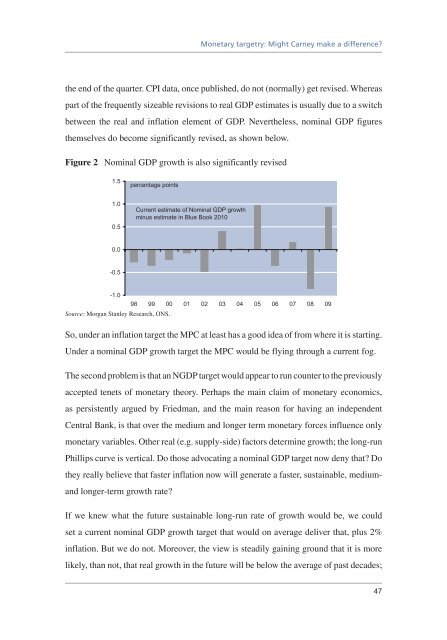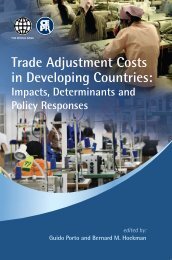Is inflation targeting dead? Central Banking After the Crisis - Vox
Is inflation targeting dead? Central Banking After the Crisis - Vox
Is inflation targeting dead? Central Banking After the Crisis - Vox
You also want an ePaper? Increase the reach of your titles
YUMPU automatically turns print PDFs into web optimized ePapers that Google loves.
Monetary targetry: Might Carney make a difference?<strong>the</strong> end of <strong>the</strong> quarter. CPI data, once published, do not (normally) get revised. Whereaspart of <strong>the</strong> frequently sizeable revisions to real GDP estimates is usually due to a switchbetween <strong>the</strong> real and <strong>inflation</strong> element of GDP. Never<strong>the</strong>less, nominal GDP figures<strong>the</strong>mselves do become significantly revised, as shown below.Figure 2 Nominal GDP growth is also significantly revised1.5percentage points1.00.5Current estimate of Nominal GDP growthminus estimate in Blue Book 20100.0-0.5-1.098 99 00 01 02 03 04 05 06 07 08 09Source: Morgan Stanley Research, ONS.So, under an <strong>inflation</strong> target <strong>the</strong> MPC at least has a good idea of from where it is starting.Under a nominal GDP growth target <strong>the</strong> MPC would be flying through a current fog.The second problem is that an NGDP target would appear to run counter to <strong>the</strong> previouslyaccepted tenets of monetary <strong>the</strong>ory. Perhaps <strong>the</strong> main claim of monetary economics,as persistently argued by Friedman, and <strong>the</strong> main reason for having an independent<strong>Central</strong> Bank, is that over <strong>the</strong> medium and longer term monetary forces influence onlymonetary variables. O<strong>the</strong>r real (e.g. supply-side) factors determine growth; <strong>the</strong> long-runPhillips curve is vertical. Do those advocating a nominal GDP target now deny that? Do<strong>the</strong>y really believe that faster <strong>inflation</strong> now will generate a faster, sustainable, mediumandlonger-term growth rate?If we knew what <strong>the</strong> future sustainable long-run rate of growth would be, we couldset a current nominal GDP growth target that would on average deliver that, plus 2%<strong>inflation</strong>. But we do not. Moreover, <strong>the</strong> view is steadily gaining ground that it is morelikely, than not, that real growth in <strong>the</strong> future will be below <strong>the</strong> average of past decades;47














